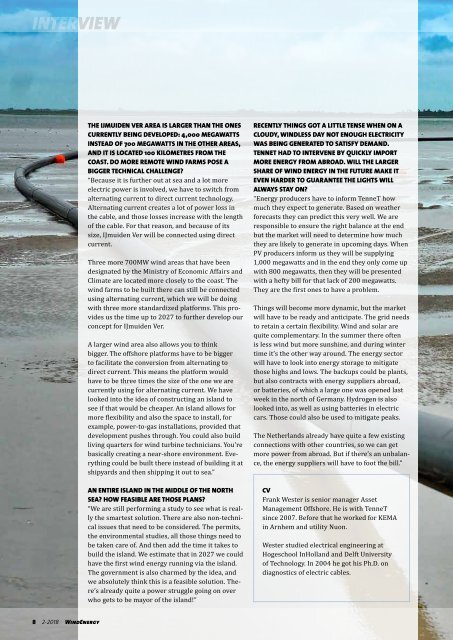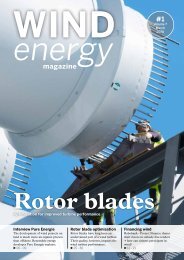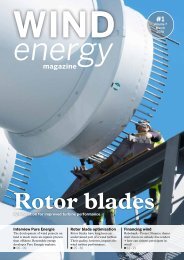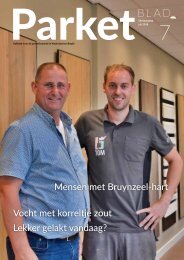WINDENERGY MAGAZINE 02 2018
Create successful ePaper yourself
Turn your PDF publications into a flip-book with our unique Google optimized e-Paper software.
INTERVIEW<br />
THE IJMUIDEN VER AREA IS LARGER THAN THE ONES<br />
CURRENTLY BEING DEVELOPED: 4,000 MEGAWATTS<br />
INSTEAD OF 700 MEGAWATTS IN THE OTHER AREAS,<br />
AND IT IS LOCATED 100 KILOMETRES FROM THE<br />
COAST. DO MORE REMOTE WIND FARMS POSE A<br />
BIGGER TECHNICAL CHALLENGE?<br />
“Because it is further out at sea and a lot more<br />
electric power is involved, we have to switch from<br />
alternating current to direct current technology.<br />
Alternating current creates a lot of power loss in<br />
the cable, and those losses increase with the length<br />
of the cable. For that reason, and because of its<br />
size, IJmuiden Ver will be connected using direct<br />
current.<br />
Three more 700MW wind areas that have been<br />
designated by the Ministry of Economic Affairs and<br />
Climate are located more closely to the coast. The<br />
wind farms to be built there can still be connected<br />
using alternating current, which we will be doing<br />
with three more standardized platforms. This provides<br />
us the time up to 2<strong>02</strong>7 to further develop our<br />
concept for IJmuiden Ver.<br />
A larger wind area also allows you to think<br />
bigger. The offshore platforms have to be bigger<br />
to facilitate the conversion from alternating to<br />
direct current. This means the platform would<br />
have to be three times the size of the one we are<br />
currently using for alternating current. We have<br />
looked into the idea of constructing an island to<br />
see if that would be cheaper. An island allows for<br />
more flexibility and also the space to install, for<br />
example, power-to-gas installations, provided that<br />
development pushes through. You could also build<br />
living quarters for wind turbine technicians. You’re<br />
basically creating a near-shore environment. Everything<br />
could be built there instead of building it at<br />
shipyards and then shipping it out to sea.”<br />
AN ENTIRE ISLAND IN THE MIDDLE OF THE NORTH<br />
SEA? HOW FEASIBLE ARE THOSE PLANS?<br />
“We are still performing a study to see what is really<br />
the smartest solution. There are also non-technical<br />
issues that need to be considered. The permits,<br />
the environmental studies, all those things need to<br />
be taken care of. And then add the time it takes to<br />
build the island. We estimate that in 2<strong>02</strong>7 we could<br />
have the first wind energy running via the island.<br />
The government is also charmed by the idea, and<br />
we absolutely think this is a feasible solution. There’s<br />
already quite a power struggle going on over<br />
who gets to be mayor of the island!”<br />
RECENTLY THINGS GOT A LITTLE TENSE WHEN ON A<br />
CLOUDY, WINDLESS DAY NOT ENOUGH ELECTRICITY<br />
WAS BEING GENERATED TO SATISFY DEMAND.<br />
TENNET HAD TO INTERVENE BY QUICKLY IMPORT<br />
MORE ENERGY FROM ABROAD. WILL THE LARGER<br />
SHARE OF WIND ENERGY IN THE FUTURE MAKE IT<br />
EVEN HARDER TO GUARANTEE THE LIGHTS WILL<br />
ALWAYS STAY ON?<br />
“Energy producers have to inform TenneT how<br />
much they expect to generate. Based on weather<br />
forecasts they can predict this very well. We are<br />
responsible to ensure the right balance at the end<br />
but the market will need to determine how much<br />
they are likely to generate in upcoming days. When<br />
PV producers inform us they will be supplying<br />
1,000 megawatts and in the end they only come up<br />
with 800 megawatts, then they will be presented<br />
with a hefty bill for that lack of 200 megawatts.<br />
They are the first ones to have a problem.<br />
Things will become more dynamic, but the market<br />
will have to be ready and anticipate. The grid needs<br />
to retain a certain flexibility. Wind and solar are<br />
quite complementary. In the summer there often<br />
is less wind but more sunshine, and during winter<br />
time it’s the other way around. The energy sector<br />
will have to look into energy storage to mitigate<br />
those highs and lows. The backups could be plants,<br />
but also contracts with energy suppliers abroad,<br />
or batteries, of which a large one was opened last<br />
week in the north of Germany. Hydrogen is also<br />
looked into, as well as using batteries in electric<br />
cars. Those could also be used to mitigate peaks.<br />
The Netherlands already have quite a few existing<br />
connections with other countries, so we can get<br />
more power from abroad. But if there’s an unbalance,<br />
the energy suppliers will have to foot the bill.”<br />
CV<br />
Frank Wester is senior manager Asset<br />
Management Offshore. He is with TenneT<br />
since 2007. Before that he worked for KEMA<br />
in Arnhem and utility Nuon.<br />
Wester studied electrical engineering at<br />
Hogeschool InHolland and Delft University<br />
of Technology. In 2004 he got his Ph.D. on<br />
diagnostics of electric cables.<br />
DC cables for offshore wind farm alpha ventus, Germany. All photos courtesy of TenneT<br />
8 2-<strong>2018</strong> WindEnergy<br />
WindEnergy 2-<strong>2018</strong> 9















